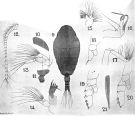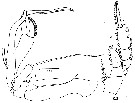|
|
 |
Fiche d'espèce de Copépode |
|
|
Calanoida ( Ordre ) |
|
|
|
Clausocalanoidea ( Superfamille ) |
|
|
|
Aetideidae ( Famille ) |
|
|
|
Chiridiella ( Genre ) |
|
|
| |
Chiridiella ovata Deevey, 1974 (F) | |
| | | | | | | Syn.: | ? Chiridiella macrodactyla : A. Scott, 1909 (p.79, 196, figs.F, Rem.) | | | | Ref.: | | | Deevey, 1974 (p.456, Descr.F, figs.F); Roe, 1975 (p.306, figs.F); Markhaseva, 1996 (p.99, figs.F); Vives & Shmeleva, 2007 (p.557, Rem.F) |  issued from : A. Scott in Siboga-Expedition, 1909, XIX a. [Plate XXXVI, Figs.9-21]. As Chiridiella macrodactyla. With doubt. Female (from Halmahera Sea): 9, habitus (dorsal); 10, forehead (lateral); 11, last thoracic and genital segments (left side); 12, A1; 13, A2; 14, Md; 15, Mx1; 16, Mx2; 17, Mxp; 18, P1; 19, P2; 20, P4; 21, terminal spine (exopodite of P4).
|
 issued from : G.B. Deevey in Bull. Mar. Sc., 1974, 24 (2). [p.457, Fig.10]. Female (from 32°10'N, 64°30'W): a-b, habitus (dorsal and lateral, respectively); c, A2; d, Md (masticatory edge); e, Md (mandibular palp); f, Mx1; g, P1; h, P2; i, P4; j, Mxp (endopod setae not shown). Scale at left margin for parts a and b; at lower right for parts c-j. Scales in mm. Nota : Head and 1st thoracic segment separate. Cephalothorax about 80 % of total body length. Urosome 25 % cephalothorax length. A1 23-segmented. Endopod of A2 about 2/3 length of exopod. Mx2 of macrodactyla type, very similar to that of C. macrodactyla A. Scott (1909), with 5 lobes (Mx2 figured by Scott lacks the small 2nd lobe and has longer setae on lobe 5, but is otherwise identical).
|
 issued from : G.A. Deevey in Bull. Mar. Sc., 1974, 24 (2). [p.459, Fig.11, e-f]. Female: e, P3; f, Mx2. Scales in mm.
|
 issued from : H.S.J. Roe in Bull. British Mus. (Natural History) Zool., London, 1975, 28 (7). [p.307, Fig.6]. Female (Cape Verde Islands): a, habitus (dorsal); b, idem (left lateral side); c, A2; d, mandibular palp; e, masticatory edge of Md; f, Mx1 (left); g, Mx1 (right); h, Mx2; i, Mxp; j, P1; k, P2; l, P4. Bar scale 0.1 mm unless indicated. Nota: Mx1 is variable: On the left side (Fig.6f) the 3rd inner lobe is absent, contrasting with Deevey's specimens, and the exopodite has 3 setae; on the right (Fig.6g) the 3rd inner lobe is present and has 1 seta, but the exopodite has only two. Mx1 of Scott's (1909) specimen differs from both this and Deevey's account. The 2nd lobe of Mx2 is very small in the present specimen, and the seta on the 1st basipodite of Mxp is present on one side only. The endopodites of P3 and P4 have only 1 segment but the lines of fusion are clearly visible.
|
 Chiridiella ovata Chiridiella ovata female: 1 - Mx2 with 5 endites. 2 - Mx2 strongly modified in comparison with typical; first-fifth endites of varying size; Setation is not typical, some number of setae on third-fifth endites transformed into pincers-like spines. 3 - Setae of fourth endite of Mx2 arranged like pincers. 4 - Endopodal segment 2 of Md with 4 setae. Mx1 with exopod, exopod with 3 setae. 5 - Protopodite of Mxp with 1 seta in distal group.
|
 Chiridiella ovata Chiridiella ovata female ; 1 - Penultimate lobe of Mx2 with 1 long and 1 short spine arranged as pincers. 2 - Mx2 with 4 or 5 lobes. 3 - A1 not extending beyond genital segment. 4 - Proximal lobe of Mx2 with 1 long seta.
| | | | | Ref. compl.: | | | Deevey & Brooks, 1977 (p.256, tab.2, Station 'S"); Vives, 1982 (p.291) | | | | NZ: | 2 + 1 douteuse | | |
|
Carte de distribution de Chiridiella ovata par zones géographiques
|
| | | | Loc: | | | off Bermuda: Station "S" (32°10'N, 64°30'W), Cape Verde Is., off Mauritania, Morocco-Mauritania, ? Indonesia-Malaysia (Halmahera Sea).
Type locality: 32°10'N, 64°30'W. | | | | N: | 4 | | | | Lg.: | | | ? (5) F: 2,73; (224) F: 2,35; {F: 2,35} | | | | Rem.: | méso-bathypélagique.
Voir aussi les remarques en anglais | | | Dernière mise à jour : 26/07/2018 | |
|
|
 Toute utilisation de ce site pour une publication sera mentionnée avec la référence suivante : Toute utilisation de ce site pour une publication sera mentionnée avec la référence suivante :
Razouls C., Desreumaux N., Kouwenberg J. et de Bovée F., 2005-2025. - Biodiversité des Copépodes planctoniques marins (morphologie, répartition géographique et données biologiques). Sorbonne Université, CNRS. Disponible sur http://copepodes.obs-banyuls.fr [Accédé le 30 novembre 2025] © copyright 2005-2025 Sorbonne Université, CNRS
|
|
 |
 |







